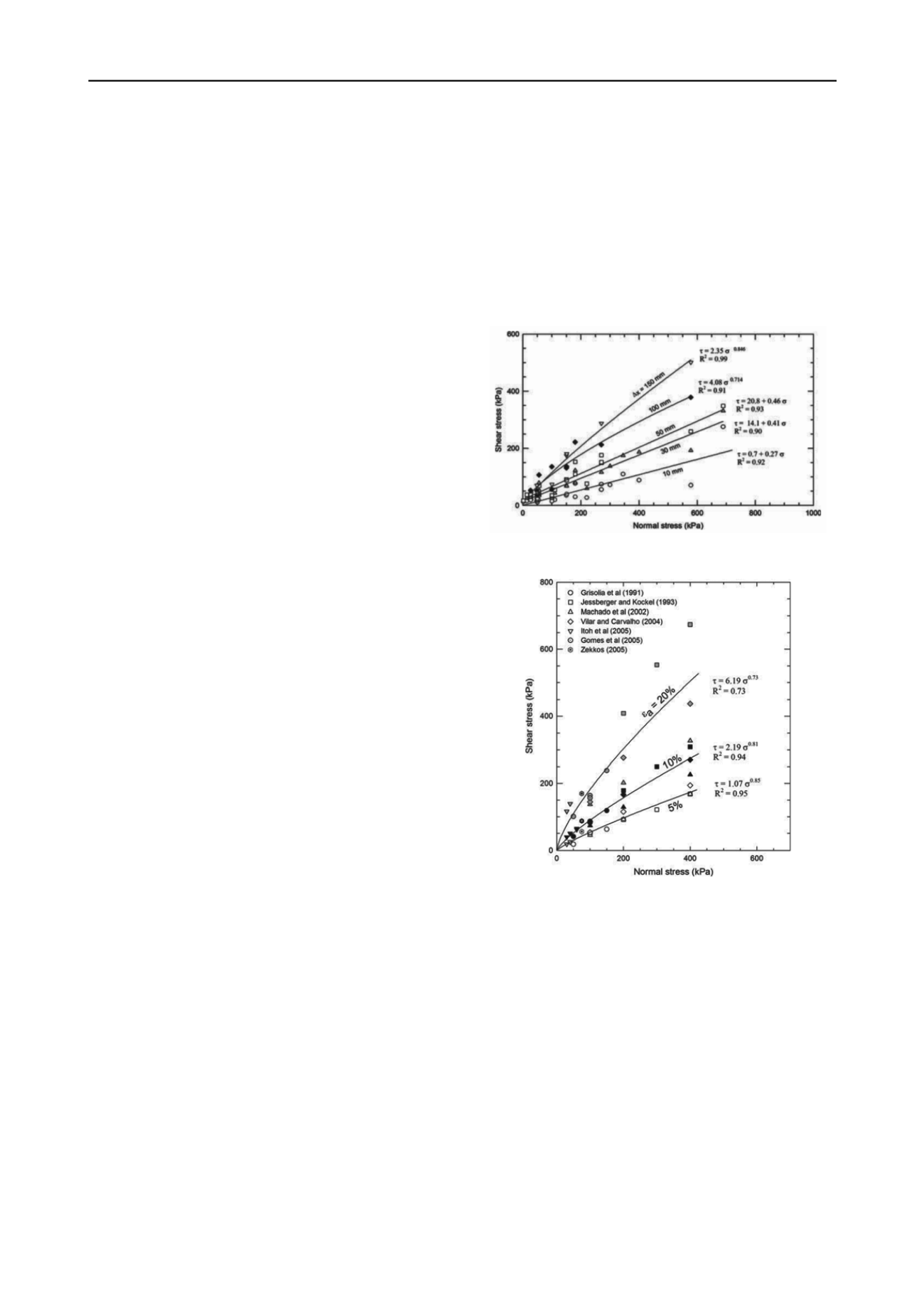
3006
Proceedings of the 18
th
International Conference on Soil Mechanics and Geotechnical Engineering, Paris 2013
The shear stress-strain curve of the MSW shows a
noticeable hardening (Grisola et al., 1996; Jessberger et al.,
1993; Eid, 2000; Zhan et al., 2008), and a horizontal
asymptotic level is not reached even with large
deformations. So it is necessary to define a certain level of
deformation in which it is assumed that the failure situation
is being reached.
3 METHODS FOR OBTAINING MSW STRENGTH
The methods for obtaining cohesion and frictional angle
parameters can be grouped in three kinds: laboratory test, in-situ
test and back-analysis of actual failures.
3.1 Laboratory tests
3.1.1 Sample conditions
Although laboratory tests are the most direct method for
obtaining the strength parameters of a material, they show
several problems that make difficult both their usage and the
subsequent interpretation when working with MSW.
The first problem is to find representative samples. Samples
obtained in the same landfill show a large dispersion in
composition due to the heterogeneity of the waste mass. Some
research has been done on “synthetic” samples, reconstituted
with the average composition of the MSW mass in the landfill
region or country (Sivakumar Babu et al., 2010).
On the other hand, among the MSW there are elements with
a medium to large size. So it is necessary to take large samples,
this is quite easy for MSW that have just arrived to the landfill,
or for recently disposed and superficial waste, but makes it
necessary to bore large diameter bore-holes (over 760 mm in
diameter) (Bray et al., 2009) for deep waste.
It is very hard to take undisturbed samples from MSW,
particularly at great depth. Densification is produced during the
sampling process due to the large deformability of MSW.
Because of the low cohesion, the loose nature of the material
and the differences in size and stiffness among the different
constitutive elements, alterations and collapses are produced
during the sampling and trimming operations.
For these reasons, tests are made using samples prepared
and compacted to in-situ density and moisture content, and with
the prevailing composition. The uncertainties associated to these
conditions make that this procedure can be only considered as
an approximation of actual landfill conditions. Besides, the
elements with a size over 1/5-1/10 of the minimum size of the
specimen to test, usually fibrous materials such as paper, plastic,
wood or metallic pieces, have to be removed or cut to fit this
size in order to not interfering with the movement of the test
equipment invalidating the results obtained. Furthermore, the
tensile strength of fibrous elements introduces an anisotropic
behaviour, making the strength obtained in the test depend on
the preferred direction of the fibres (Bray et al., 2009).
3.1.2 Test types
The tests used to obtain strength parameters are direct shear,
triaxial and simple shear tests.
From 23 research works revised by Stark et al. (2009), dated
from 1990 to 2005, 48% used laboratory direct shear tests, 22%
triaxial tests, and just one simple shear tests. The rest of them
are in-situ direct shear tests. Recently, Bray et al. (2009) have
presented the results of simple shear tests on 400x300 mm
rectangular samples.
In general test specimens have a relative large size. It is
frequent for the direct shear test probes to have a length of 300
millimetres or more and using triaxial specimens with over
200mm in diameter. Besides, the test equipment has to be
prepared to provide large deformations. This circumstance is
stated on plenty of the revised researches, and makes it
necessary to modify the original design of the equipment.
3.1.3 Other aspects
In tests on MSW samples, the applied shear stress increases
monotonically with deformation, and in most cases a maximum
or asymptotical value is not reached even with the application of
large displacements. The plots shown in Figures 1 and 2 belong
to a compilation of results from several authors made by Stark
et al. (2009). It is shown that shear stress does not grow only
with the applied normal stress, but it also increases with the
deformation or the displacement reached. Those authors
attribute this behaviour to the reinforcement action of the
wastes’ fibrous elements when deformation increases.
Figure 1. Summary of direct shear lab tests (Stark et al., 2009)
Figure 2. Summary of triaxial lab tests (Stark et al., 2009)
It has to be taken into consideration that in regular landfill
operation the possible deformation is much smaller than during
a test. Movement compatibility between MSW and the more
rigid sealing layers, and also with the deformation limit of
draining elements, gas evacuation elements, etc., limits waste
deformation to acceptable levels, forcing the definition of
strength parameters to an imposed deformation value (Machado
et al., 2002).
The environmental conditions where the laboratory tests are
conducted are problematic because of the odour and the
hazardous sample management, making necessary to fit out a
specific area, isolated from the rest of the laboratory. In some
research it is necessary to carry out most of the tests in facilities
belonging to the landfill grounds.
The difficulty in obtaining truly representative samples and
test environmental conditions affects negatively to the
possibility to undertake systematic shear strength laboratory test
campaigns. The revised bibliography shows that there are a
scarce number of tests executed for the amount of means
mobilized (Bray et al., 2009, Sivakumar Babu et al., 2010).


